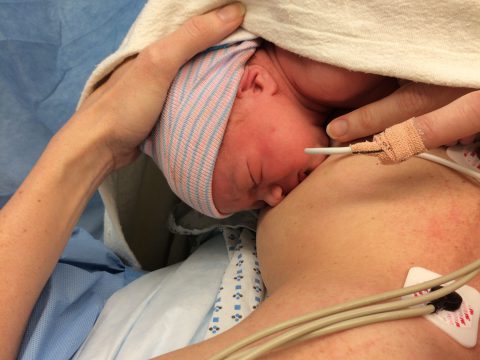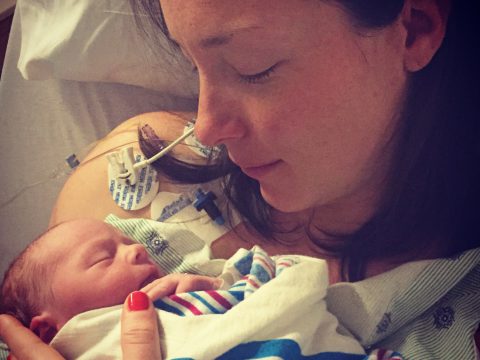
Cesareans are Healthiest for Children When They Follow at Least Some Labor, a Study Says
We have known for some time that babies born by cesarean have an increased risk of health problems. Now, the largest and longest study ever conducted on the health impact of planned cesareans finds that the timing of a cesarean is a factor in how likely a child is to experience these health challenges.(i) Researchers followed children for a 15-year period and found that children born by cesareans after some labor had a 35% lower likelihood of developing type 1 diabetes than those born by planned cesarean.
A New York Times article put it this way:
“Surprisingly, the data showed more health problems among babies born by planned C-section than among those delivered by emergency C-section or vaginal birth, even though the planned surgery is done under more controlled conditions. The finding suggests that the arduous experience of labor — that exhausting, sweaty, utterly unpredictable yet often strangely exhilarating process — may give children a healthy start, even when it’s interrupted by a surgical birth.”(ii)
Dr. Sarah Buckley in a separate report points to research that also supports waiting until labor begins if at all possible. Studies on humans and animals have found that in the days and hours leading up to labor, cells in the uterus, brain and mammary glands have an increase in the number of oxytocin receptors.(iii) This would make the oxytocin circulating in the blood stream during and after birth more usable by the body. As I discuss in the The Mindful Cesarean Toolkit for a Healthy Birth, oxytocin is one of nature’s heavy lifters when it comes to launching a healthy and bonded mother and her baby. When a baby is born by cesarean, oxytocin processes for mother and baby, including the mother’s late-in-labor oxytocin surge and postpartum oxytocin peaks, can be reduced or absent.(iv) It is therefore especially important with a cesarean to do all we can to enhance this healthy birth hormone. Waiting until labor begins if possible may help mother and baby get off to a strong, connected start.

Discuss with your doctor whether or not you are a good candidate to wait for labor to start on its own. If so, you would do your early labor at home or in the hospital and then move to the operating room for a cesarean as contractions pick up.
For example, if a woman is carrying a baby who is a breech and her doctor recommends a cesarean birth, she might request to labor at home through her early labor. She would be in good touch with her doctor throughout early labor and at some point travel to the hospital, get an ultrasound to determine the baby’s position, and then either continue laboring if the baby has changed positions, or birth by cesarean if that is the safest way for her baby to be born.
Currently, if a cesarean is indicated, many doctors recommend scheduling a cesarean in advance of labor for a variety of reasons (so that you get your chosen doctor, a prime morning time-slot, controlled conditions, etc.). Ask your doctor if she has seen the research showing that parents might want to wait for labor to begin whenever possible. Explore your options.
Keep in mind that there are medical situations when any labor may be ill-advised and the benefits of a planned cesarean outweigh the risks. If a planned cesarean is your best option, focus on the benefits. Discuss with your doctor whether it is safe to schedule the cesarean as close as possible to when your baby would be likely to come.
In-Labor Cesarean
We currently describe a cesarean as a “planned cesarean” (scheduled and performed in advance of labor) or an “emergency cesarean” (one that happens once labor is underway). And yet, the vast majority of emergency cesareans are in no way emergencies. As a doula, I can recall three couples in the last two years in busy New York City hospitals who waited two, four, and five hours from the time an “emergency” cesarean was called until we entered the operating room (all called for labor distocia and/or Category II fetal heart rate decelerations following inductions). These women labored, and then birthed by unhurried, non-emergency cesareans. I would suggest reserving the term emergency for those rare, truly time-sensitive emergencies.
In-labor cesarean is a term we can use to describe any cesarean where labor precedes a non-emergency surgical birth, including the option of allowing labor to begin on its own and then, as contractions build, going in for a cesarean (or an assessment as to whether cesarean is still the best way to birth).
If your doctor is scheduling a cesarean for you, discuss whether or not you are a good candidate for an “in-labor cesarean.” Or, as I mention above, whether you can at least wait until close to when your baby is due.
(i) Black, M., Bhattacharya, S., Philip, S., Norman, J.E., & McLernon, D.J., “Planned cesarean delivery at term and adverse outcomes in childhood health,” JAMA 314(21) (2015):2271-9. doi: 10.1001/jama.2015.16176. Retrieved from http://www.ncbi.nlm.nih.gov/pubmed/26624826, December 2015.
(ii) Rabin, R.C., “C-Sections are best with a little labor, a study says,” New York Times (Dec 14, 2015). Retreived from http://mobile.nytimes.com/blogs/well/2015/12/14/c-sections-are-best-with-a-little-labor-a-study-says/, Dec 2015.
(iii) Sarah Buckley, “Hormonal Physiology of Childbearing,” J Perinat Educ. 2015; 24(3): 145–153. Retreived from https://www.ncbi.nlm.nih.gov/pmc/articles/PMC4720867/
(iv) Sarah Buckley, “Hormonal Physiology of Childbearing,” p. 92


